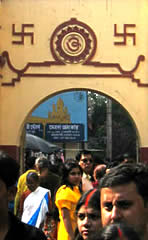HINDU STUDENT COUNCIL TO EXPLAIN ORIGINS OF SWASTIKA [[Traduit de l’Anglais par Hélène LE, pour www.buddhachannel.tv ]]
31/ 01/ 2008
It is a symbol that is iconic and infamous – a cross with bent arms – known as the swastika. Though the swastika has long carried a negative connotation in the Western world, the Hindu Student Council hopes to dismiss misconceptions about the symbol in their presentation “Swastika Awareness.”

“We just want to erase preconceived notions about the swastika,” said Teja Kavi, a junior biomedical science major and the public relations officer for the HSC. “Some people relate it only to the bad part of the symbol, but there’s more to it.”
The swastika was established before Hitler attached the symbol to armbands or displayed it on raised red flags. Derived from the Sanskrit “svastika,” meaning “good to be,” the swastika began as an Indo-European mark meant to bestow good luck.

« the swastika represents the cycle of birth, suffering, death and rebirth »
One of two main symbols in Hinduism, the swastika represents the cycle of birth, suffering, death and rebirth. Jainism and Buddhism use the symbol for positive representation.
The event will detail different values and implications of the symbol, touching upon perceptions and uses of the symbol around the world.
“We’re fighting for people to know other meanings to it,” Kavi said. “There are two main ways the symbol can be portrayed.”
The swastika is a cross with bent arms that form right angles to the left or right. Hitler’s swastikas tilted to the left with bright red arms popping off a whitewashed background, while the Hindu swastika stands upright and sometimes includes four dots inside.
“I think a lot of people are unaware that there is a difference, and when you’re aware, there’s more respect,” Kavi said.
Swastika education was not well received in 2007 in one of the residence halls when a description of both meanings was exhibited. The display was defaced and eventually torn down.
“They want to educate what it means to them,” said Patrick Lukingbeal, graduate student in education administration. “Some people are going to be upset about it because how it was used in Nazi Germany, but they have been trying to be very intentional about how they advertised this event.”
E-mails, fliers and Facebook were tools used to spread the word about the event. The HSC has plans to display the Hindu swastika and doesn’t want to shock the campus or isolate themselves from fellow Aggies.
 “We are having the symbol put on our T-shirts,” Kavi said. “We want people to be aware of it and not just think we’re wearing Nazi symbols.”
“We are having the symbol put on our T-shirts,” Kavi said. “We want people to be aware of it and not just think we’re wearing Nazi symbols.”
The HSC informed student organizations about the event, working to notify rather than cause controversy. Rabbi Yossi Lazaroff, director of the Chabad Jewish Center, said toleration is necessary for Hindus and Jews.
“Everyone should understand that Hindus are not being insensitive to Jewish people, and the Jewish people have to understand that Hindus and their swastika have nothing to do with Nazi Germany,” he said.
Lazaroff said he clings to a simple motto: challenging the student body to value enlightenment over common misconception.
“We need to be respectful of other people’s religions,” he said. “Live and let live.”
The Department of Multicultural Services helped coordinate the informational. Lukingbeal worked with the department and said that a willingness to understand is what the HSC asks of the student body.
“It’s going to invoke feelings, but the students want to paint the picture that the symbol came from a peaceful religion, being the Hindu faith,” he said.
“We are trying to enlighten A&M,” Kavi said. “We’re doing something different. I know it’s a conservative campus, but it’s about time that people are notified about what’s good and what’s bad. I think our students are ready to see that. Someone has to start somewhere. I think we’re taking the first step.”
According to the organization’s website, the purpose of HSC is to “to spread the awareness of Hindu religion and culture while promoting individual spiritual growth.” The roughly 50-member group welcomes everyone willing to learn, offering students a cultural experience rather than a religious event.
By Amanda Casanova
Source : www.thebatt.com (The Independant Student Voice of Texas)




